IonQ CRO Alameddine Rima sells $4.6m in shares
If you squint, can you see an effect of the deportations of illegal aliens in yesterday’s CPI report?
I don’t want to encourage anyone to obsess over every detail of the report. That’s almost always a fraught exercise. But there were at least a couple of things in the data this month that could indicate both inflationary and disinflationary effects of the deportation campaign. A serious part of my brain is saying, ‘come on, there just haven’t been many deportations in the context of the population of illegals, how can we see an effect?’ And that instinct is probably right.
Before we get into yesterday’s release, let’s remember that there is one important context to keep in mind, and that is that unless there are major surprises to the downside, core and headline inflation are going to be accelerating for most of the rest of the year on a year-over-year basis. I discussed this in a short podcast last week. So we need to keep in mind, as we think about markets and policy, that the optics are going to look worse for a while here.
That is, unless we get numbers like we did in the May CPI, which was a major miss due mostly to very soft figures on rent inflation. Last month, Primary rents were +0.213% m/m and Owner’s Equivalent Rent (OER) was +0.275%. Rents are decelerating, but not that quickly. If they did, then a 2% target on inflation becomes at least possible. It’s not yet possible.
The consensus for yesterday’s number was +0.26% on headline and +0.25% on core CPI. Right in the middle of 0.2% or 0.3% rounded prints. What happened is that we got one that ticked up and one that ticked down. Actual CPI was +0.287% on headline, and +0.228% on core inflation.
That caused the year/year headline number to print +2.7%, up from 2.4% last month (and higher than 2.6% expected), and y/y core to be 2.9% (vs 2.8% last month, and as-expected). The usual suspects trumpeted ‘another miss softer on core CPI! Rate cut on tap for September!’ But what is the real story?
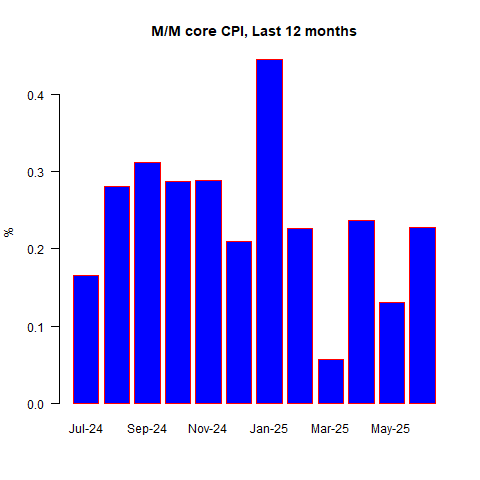
The real story is not nearly that encouraging. As we will see, there are quite a few signs that the core miss was an aberration. Not a bad one, but deceiving.
Here is my guess at Median CPI.
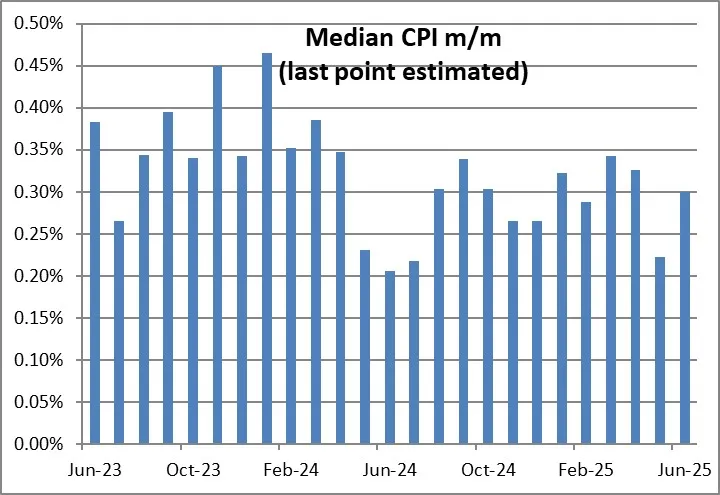
The median category is likely the West Urban OER subcategory, which means that the actual median will depend on where that seasonal adjustment comes down. But two of the four OER subcategories are higher than that, so I doubt my guess is wildly off (when it isn’t one of those subcomponents, I nail the median but because they split up OER, sub-seasonals matter). So the median should be around 0.30%, or 3.6% annualized. Median CPI has rounded to 3.5% y/y since February, and it’ll be there again. That looks like progress has stopped. The chart below doesn’t include yesterday’s figure, but illustrates that we’re seeing a flattening out of progress.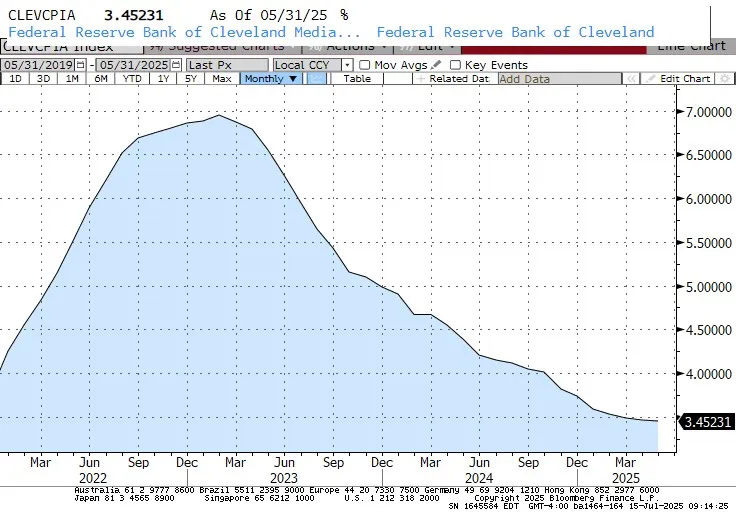
Now, this is what we would expect if tariffs were starting to affect prices generally, is that median would accelerate a little bit but core not necessarily. However, tariffs aren’t going to affect prices generally. They’re going to affect core goods primarily. So what is going on here?
One clue is that there was only one category this month that had an annualized monthly change of less than -10%. Normally there are a handful of categories on the tail (for example, there were 8 categories – in the way we slice them up for calculating Median CPI – where the annualized monthly rise was greater than +10%). This one category was Lodging Away from Home. Month/month was -2.9%, and year-over-year changes in hotel prices are at -2.5%: near the lowest levels since the sharp declines during COVID.
That may be where we squint and see a positive (lower inflation) effect of the deportations. We should expect that mass deportations should cause a relief on upward pressure on certain goods and services that happened when 8mm+ new residents arrived over 4 years. Folks love to focus on the wage effects as being inflationary (more on that in a moment) but they forget that you’re removing a bunch of consumers and while not 100% of illegal aliens work, 100% of them consume. And one of the things they consume is shelter. To be sure, we haven’t had anything remotely like ‘mass’ deportations yet. But releasing some of the hotels that were being paid for by cities to house migrants is one place that it’s totally understandable we should see a positive effect. The effect on home prices will come later.
While some pressure may continue to come off of shelter inflation, there’s this disturbing trend in Tenants and Household Insurance – and that’s before State Farm announced a 27.2% increase for Illinois. Yuck!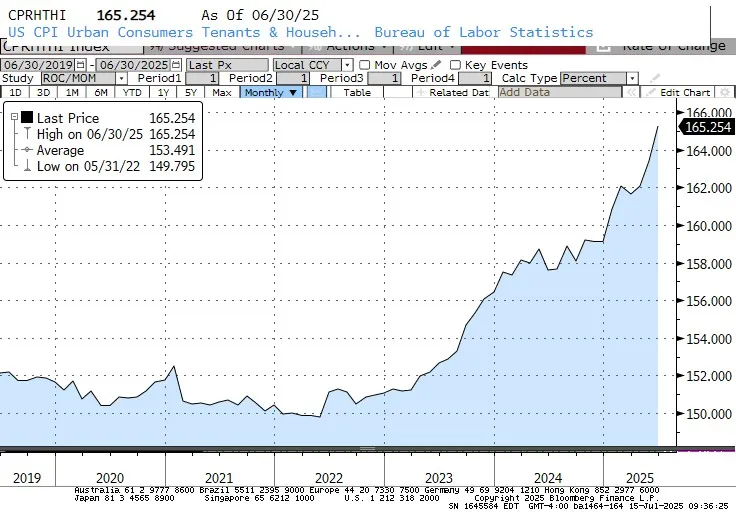
To be balanced on the deportation issue, let me point out something that comes up in the ‘four pieces charts’. Piece 1 is Food and Energy; Piece 2 is Core Goods; Piece 3 is Core Services less Rent of Shelter aka Supercore; Piece 4 is Rent of Shelter.
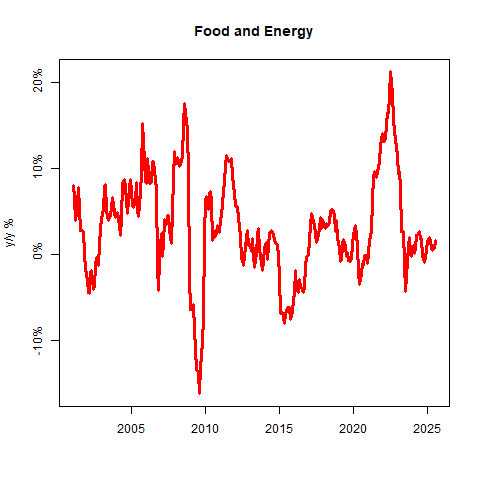
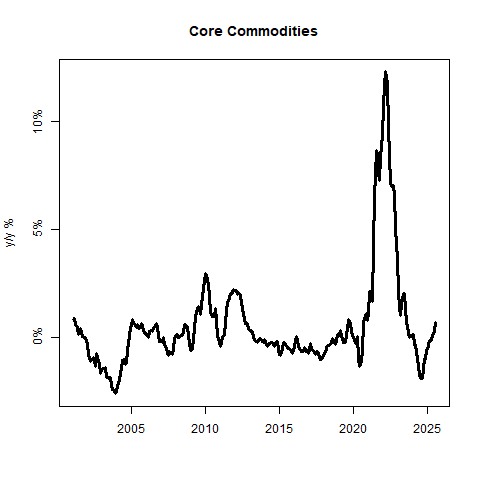
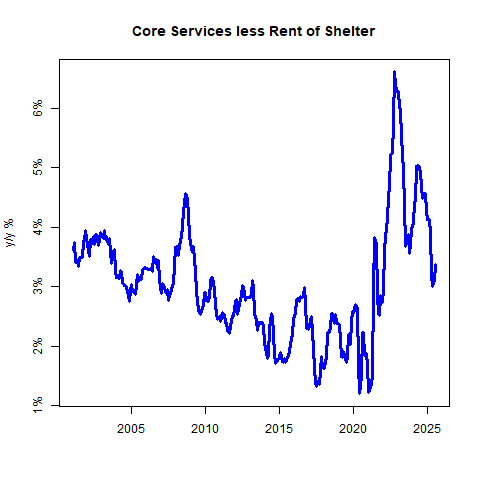
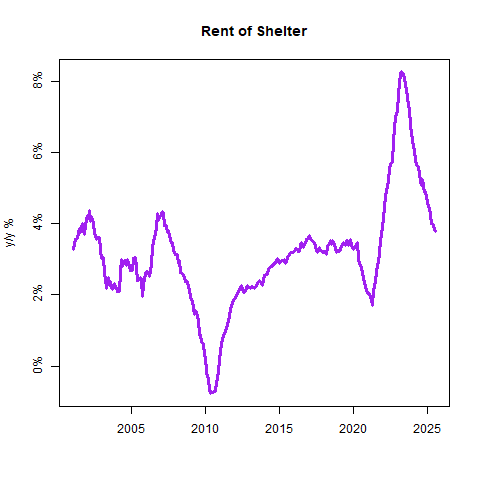
First, notice that core goods continues to trend positive – finally. Y/Y core goods went to +0.7% from +0.3%, despite continued softness in autos. The auto softness will not last forever; some of it is likely due to front-running tariffs. But more interestingly, note the small but measurable hook higher in Supercore. That’s where wages show up most strongly, so if deportations are causing better wages, we would expect that. So is this a deportations effect at the margin? I doubt it. As I said before, deportations are no where near “mass” yet so I’d be surprised to see an effect there. But watch this space.
So how excited are we about the core surprise lower?
The answer is not at all. Core goods is trending positive and while I don’t expect a massive tariff effect I am pretty sure it won’t be negative. Core services is going to have some upward pressure if deportations turn out to make a difference at all. Eventually, the effect on shelter and on other goods and services demand will be disinflationary but timing-wise that’s going to be after the tariff effect. And in the meantime, monetary aggregates are accelerating again in the US and Europe.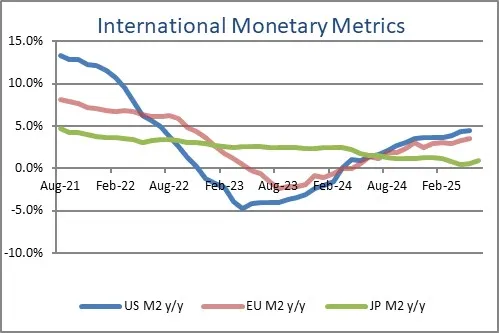
Is the story, then, that core inflation is going to continue to surprise to the downside? Well, when you look at the broader picture, at not only which prices are rising and falling but how broadly it’s happening, the news is not all unicorns and rainbows. Here is a chart of the weight of the CPI basket that is inflating at faster than 4% y/y.
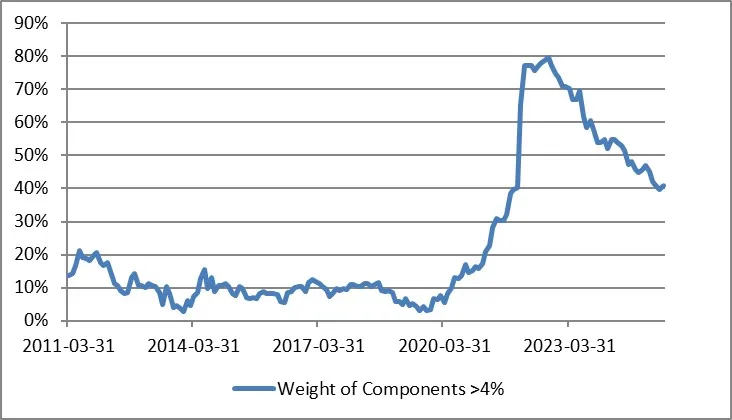
That has improved, but I can’t help but notice that it is not even vaguely in the vicinity of pre-COVID. How can we get overall inflation to 2% if nearly half of the basket is inflating faster than 4%? Well, you’d need core goods to be really soft, and that part is done.
We can see that also in the Enduring Investments Inflation Diffusion Index (EIIDI), which has been sub-zero for a while but this month, jumped to positive.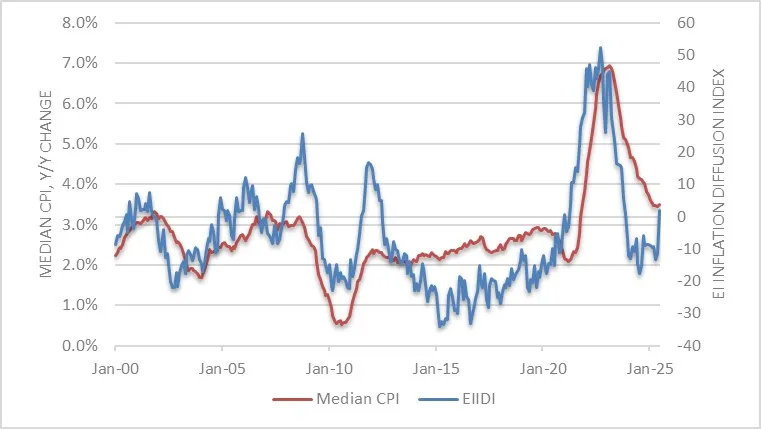
These tell the same story – this month we could get all excited about the core miss…except that outside of Lodging Away from Home, the story isn’t so happy.
From a policy standpoint, there is just no reason to drop rates below neutral and we’re pretty close to neutral right now. Here’s something to think about (but the Fed won’t think about this because they don’t pay attention to money). Abstract from tariffs for a moment – tariffs are never a reason to maintain higher rates, because they are a one-off. But let’s suppose you believed that mass deportations would push up inflation and wages. The argument for a central banker would be that fewer workers in the economy implies a smaller economy, and a smaller economy needs less money. Therefore, while tight Fed policy can’t affect tariffs, they could affect prices that are rising because of deportations.
Again, let me clarify that I don’t think deportations are doing anything yet, and I think they’re as likely to push prices down in shelter and some core goods as they are to push wages and prices higher in services. I’m just saying that if you think deportations are inflationary, there is a monetary policy response that makes sense, and it isn’t easy money.
So, unless the economy starts to soften more seriously, there just isn’t a good argument right now for rate cuts. And now that the y/y numbers are heading higher because of base effects at least, the optics are going to be worse for the Fed to consider an easing. There is always an ‘unless’, and here the ‘unless’ is ‘unless Powell resigns and is replaced with an uber-dove.’ I can’t imagine that Powell wants to be the first Fed chairman ever to resign in disgrace, and no one can force him out, but stranger things have happened. However, I can’t handicap politics. I’m only handicapping inflation.
